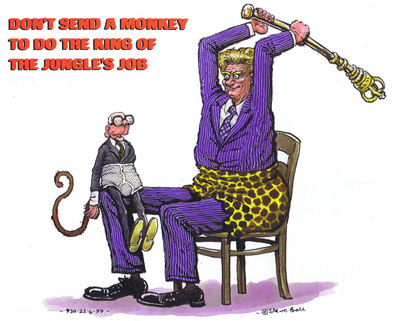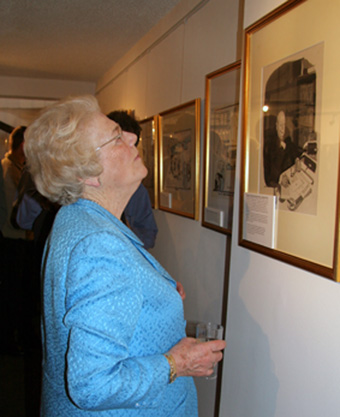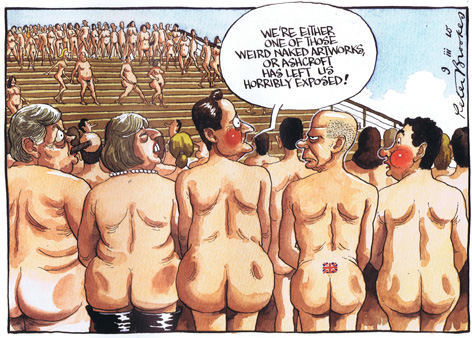Depicting politicians in political cartoons
Do politicians actually enjoy being depicted in political cartoons? Steve Bell, for one, thinks not. He told me that all the politicians he had discussed it with made out that they loved it, but he feels the reality is that they do not at all enjoy being visually ridiculed. However, Winston Churchill seemed to think politicians did indeed like it, and he would have known better than most. In a career spanning almost 60 years of frontline politics, he became the political figure most profusely cartooned in the history of editorial cartooning. Churchill believed that being featured in a cartoon emphasised a politician's importance. In fact, politicians, according to Churchill, should be more concerned when they stopped appearing in them as he himself noted:
“Just as eels are supposed to get used to skinning, so politicians get used to being caricatured. In fact, by a strange trait in human nature they even get to like it. If we must confess it, they are quite offended and downcast when the cartoons stop... They murmur: ‘We are not mauled and maltreated as we used to be.’ The great days are ended.”
Former Labour MP and peer, Manny Shinwell, also believed this to be the case, as he once put it to former Daily Express cartoonist, Michael Cummings: "My boy, however angry politicians may get by the way you draw them in your cartoons, they'll be more angry if you leave them out!" The caricaturist Gerald Scarfe has stated that sometimes his ''victims'' turned out to be fans, adding: ''They would rather be noticed than not noticed, even if it is a lousy depiction." Disgraced former Labour MP, Denis MacShane, when Europe minister in the Blair Government, was absolutely thrilled at being depicted for the first time by Martin Rowson in the Guardian. He not only telephoned the cartoonist that morning to request the purchase of the original, but also begged Rowson to include him in more of his cartoons in the future.
Before the advent of television and when radio was still in its infancy, cartoonists were,, as a result, far more influential than today. Believe it or not, Politicians would regularly used to encourage cartoonists to draw them by using what David Low termed 'tags of identity'. For example, former Conservative Prime Minister, Stanley Baldwin, was keen to be depicted smoking his pipe, which he believed gave him an affinity with the common man. Other politicians promoted their image for the benefit of the cartoonist even if detrimental to their person. For example, former Conservative leader and Foreign Secretary, Austen Chamberlain, in an attempt to emulate his famous father Joseph, would wear only a monocle even though he was dreadfully shortsighted. This meant that he could barely recognise people at a distance greater than a few feet. On one occasion while sitting for David Low, Chamberlain asked, “Must I wear my monocle? I cannot see to read with it very well.” Such blatant attempts by politicians to portray themselves in a favourable light explain why Churchill became so keen to promote himself this way using cigars, hats, and of course the V sign.
Cartoonists occasionally even complained about prominent politicians who had no tags of identity. For example, Harold Wilson and David Low were members of the same golf club. At a chance meeting in the clubhouse, Low complained directly to Wilson, who, according to the former Prime Minister, "shook his head sadly at him because he couldn't find anything in him to seize onto." Within weeks, Wilson, like Baldwin before him, was suddenly seen everywhere with a pipe in his mouth.
Some cartoonists have been very successful over the years in getting under the skins of major political figures. It seems to help that those politicians who reach the top of the greasy pole appear to lose any self-deprecating sense of humour they may have had when they began their ascent. The pressure of being a frontline politician means they somehow become incapable of laughing at themselves. Former Labour Prime Minister, James Callaghan, was so disturbed by The Sun’s Stanley Franklin continued depiction of him as the ever-hopeful Wilkins Micawber from Dickens' David Copperfield that he confronted the cartoonist directly. Franklin's defence was that it was the prerogative of the press to attack the Prime Minister. Callaghan’s exasperated response was, "Yes, I know, but every day?"
Sir Norman Fowler told me that John Major (once his Junior Minister), was very sensitive to being ridiculed in cartoons, while Prime Minister. Major was particularly hurt by Steve Bell's portrayal of him as an ineffective Superman sporting Y fronts over his trousers. "These cartoons are done to destabilise me, so I ignore them," he purportedly told a colleague.  Major was also upset by Spitting Image’s depiction of him as a dull, boring grey puppet whose only pleasure in life was enjoying a meal of peas with his wife Norma. A frustrated Major told Mathew Parris that he “hated peas!!!” This would not have displeased the creator of Spitting Image, Roger Law, who felt he had failed if any politicians actually liked the puppet of themselves. For example, former Conservative Minister, John Gummer, paid a fortune for his spitting image puppet. On the other hand, former Conservative Home Secretary, Kenneth Baker, hated the puppet of himself as a greasy slug leaving a trail of slime wherever it went. Consequently, Baker said of Spitting Image that it, "lacked subtlety and wit - it was an art form that destroyed itself by its own cruelty. It kicked people and figuratively cut off their arms and legs." Of course, there was no love lost on either side. I once heard Roger Law say on radio that, given the chance, he would “loved to have taken a claw hammer to Baker”.
Major was also upset by Spitting Image’s depiction of him as a dull, boring grey puppet whose only pleasure in life was enjoying a meal of peas with his wife Norma. A frustrated Major told Mathew Parris that he “hated peas!!!” This would not have displeased the creator of Spitting Image, Roger Law, who felt he had failed if any politicians actually liked the puppet of themselves. For example, former Conservative Minister, John Gummer, paid a fortune for his spitting image puppet. On the other hand, former Conservative Home Secretary, Kenneth Baker, hated the puppet of himself as a greasy slug leaving a trail of slime wherever it went. Consequently, Baker said of Spitting Image that it, "lacked subtlety and wit - it was an art form that destroyed itself by its own cruelty. It kicked people and figuratively cut off their arms and legs." Of course, there was no love lost on either side. I once heard Roger Law say on radio that, given the chance, he would “loved to have taken a claw hammer to Baker”.
Another Conservative politician who despised the way he was depicted in cartoons was F E Smith, later Lord Birkenhead. While Conservative Attorney General in the 1920s, Smith complained bitterly to the proprietor of the Evening Standard, Lord Beaverbrook, about his paper’s cartoonist, David Low:
“Your cartoonist over a long period of time published filthy and disgusting cartoons of me which were intended and calculated to do me great injury... I know about modern caricature and I never had cause for grievance until you, a friend, allowed a filthy little socialist to present me daily is a crapulous and corpulent buffoon.”
Low was obviously highly effective at getting up the nose of senior Conservative politicians, as at roughly at the same time, Prime Minister Stanley Baldwin referred to Low as "evil and malicious". Churchill also bitterly attacked Low as a scoundrel, whom he said, “never drew a single line in praise of England”. There were even times in 1940, when Churchill, under enormous pressure due to Britain's precarious position, believed Low was even a dangerous subversive, doing great harm to the morale of the country.
In fact, Winston Churchill’s vanity was notably pricked by another great cartoonist, Leslie Illingworth after a cartoon he drew for Punch in 1953 suggested it was time the then 78 year old Prime Minister retired. The cartoon entitled ‘Man goeth forth unto his work and to his labour until the evening’ showed Churchill listless at his desk with his face showing the unmistakable effects of a partial paralysis he had suffered the preceding summer. Churchill was bitterly hurt by the cartoon because it showed him as he truly was, not as he wanted to be portrayed. Churchill said of the cartoon: "Yes, there’s malice in it. Look at my hands - I have beautiful hands… Punch goes everywhere. I shall have to retire if this sort of thing goes on.” Churchill’s doctor, Lord Moran though noticed the truth in the cartoon: "The eyes were dull and lifeless.There was no tone in the flaccid muscles; the jowl sagged. It was the expressionless mask of extreme old age." Malcolm Muggeridge who as Editor of Punch had given the go ahead for the cartoon, became well known later in Churchill circles as ‘Buggeridge’.
 (LEFT) Winston Churchill's daughter, Mary Soames, looks at the infamous Illingworth cartoon at the Politcal Cartoon Gallery in May 2005However, no cartoonist was ever successful in antagonising Margaret Thatcher, the one Prime Minister Steve Bell has referred to as the true “antichrist”. I spoke to a number of Thatcher's former ministers to find out why. They all told me that apart from obviously being very intelligent, she did not have a great sense of humour and most importantly, did not understand irony. As a consequence, the visual barbs went straight over her head. Matthew Parris told me that, in any case, she refused to look at cartoons of herself. Her PR people, colleagues and even her family were instructed not to show her any disrespectful or hurtful cartoons.
(LEFT) Winston Churchill's daughter, Mary Soames, looks at the infamous Illingworth cartoon at the Politcal Cartoon Gallery in May 2005However, no cartoonist was ever successful in antagonising Margaret Thatcher, the one Prime Minister Steve Bell has referred to as the true “antichrist”. I spoke to a number of Thatcher's former ministers to find out why. They all told me that apart from obviously being very intelligent, she did not have a great sense of humour and most importantly, did not understand irony. As a consequence, the visual barbs went straight over her head. Matthew Parris told me that, in any case, she refused to look at cartoons of herself. Her PR people, colleagues and even her family were instructed not to show her any disrespectful or hurtful cartoons.
Politicians generally only acquire original cartoons of themselves that flatter them. During his long career in politics, Michael Heseltine built up a huge collection of original cartoons that depicted him as Tarzan. It must have obviously suited his purpose to be projected as lord of the ‘political’ jungle. Andrew Mitchell, MP bought a number of original cartoons in 2013 in reference to the “Plebgate” affair, of which he was at the centre. He told me, in reference to the affair, "There have been horrible cartoons of me and some nice ones. I buy the nice ones." It is no surprise that the disgraced Conservative peer, Jeffrey Archer, has built up a large collection of cartoons but, guess what, has none of himself.
When politicians do complain about the way they are drawn, it is usually more for reasons of vanity rather than of criticism of their policies. Politicians tend to be highly sensitive about how they look in cartoons. In the 1960s, Labour leader, Hugh Gaitskell, bemoaned the way he was caricatured by Vicky, even asking the cartoonist's colleague at the Evening Standard, Milton Shulman, to speak to Vicky about the way he drew Gaitskell’s nose. "He makes it look like a ski run, Gaitskell told Shulman, running his fingers down his nose. "It's not sharp at all. Can't he be more accurate?"
I held the opinion that Tony Blair was indifferent to ridicule by the cartoonists and thus just ignored it. According to Nick Brown however, one of his former ministers, this was not the case. Blair was indeed incredibly vain about his appearance. As a defence mechanism, he would affect indifference. Brown added that Blair always wanted to appear "masculine". What Blair especially hated was being drawn with oversized ears and an ever-receding hairline. According to Brown, Steve Bell's cartoons in Tribune especially got under Blair's skin.
The last two Prime Ministers, Gordon Brown and David Cameron, have both been particularly touchy in regard to cartoonists making them appear overweight. This really has struck a raw nerve with both men. Dave Brown, of the Independent, said that he had briefly met Gordon Brown when he was Prime Minister. He had said to him, "You draw me far too fat. I'm not that fat." Martin Rowson met Gordon Brown when Chancellor, and recounted a similar conversation. "He replied to my various points of policy by saying, "Why do you draw me so fat?" I think I said it was because he was fat. He made his excuses and left."
Former Daily Telegraph cartoonist, Nick Garland, has said that Brown should have been flattered by the way he has been portrayed in cartoons. "All of us drew Brown as hulking and big. He should take that as a compliment. He is a heavyweight figure, a presence." Garland also said that it was preferable to the way William Hague has been depicted, "as an ever-shrinking gnome" despite being 6ft 1 inch tall. Hague is another politician who has been riled by his depiction. He used to complain to the cartoonists that they drew him too small, pointing out to them that he was about the same height as Tony Blair. The reason for his 'smallness' had more to do with the then public's perception of him. According to cartoonist Dave Brown, it was “because of his insignificance as Tory leader at a time when his party offered no genuine challenge to Labour. As a consequence, every cartoonist would always draw him much smaller than Blair and usually in the form of a child or schoolboy. As a result of his treatment, Hague has become contemptuous of cartoonists, having once told me, "They, in any case, invariably get it wrong”.
Before he became Prime Minister, David Cameron seemed naively keen on being depicted in cartoons. In 2009, Cameron was “intrigued” when I informed him that I was putting on an exhibition of original cartoons of him, entitled Cameron in Caricature at my Political Cartoon Gallery in London. He immediately sent one of his flunkies down to see the exhibition with the idea of using one of these cartoons as a Christmas card for himself. The flunkey was disappointed to find that the cartoons mercilessly ridiculed Cameron and the idea was, not surprisingly, quickly dropped.
As I mentioned in last year's cartoon anthology, Cameron has been greatly irked by Steve Bell's depiction of him with a condom over his head. Cameron foolishly told Bell, “You can only push a condom so far.” This proved disastrously counter-productive. First, it showed that Bell had touched a raw nerve, and second, it only encouraged the cartoonist to continue using the condom.
As I said, Cameron has been equally sensitive about being depicted as fat. He complained to The Times when Peter Brookes drew him naked with a bigger bottom than the rest of his Cabinet. Christian Adams of the Daily Telegraph recently met Cameron at a function, where the Prime Minister complained to him about the way he also drew him: "Why do you draw me so fat? I'm not fat. Look at Michael Gove over there. He's much fatter than I am but you don't draw him as fat, only me you depict as fat." Adams responded by telling the Prime Minister he did not help himself by wearing such tight-fitting running kit when out jogging!
 (RIGHT) David Cameron complained to The Times about the size of his bum in this cartoon.
(RIGHT) David Cameron complained to The Times about the size of his bum in this cartoon.
 View Account
View Account